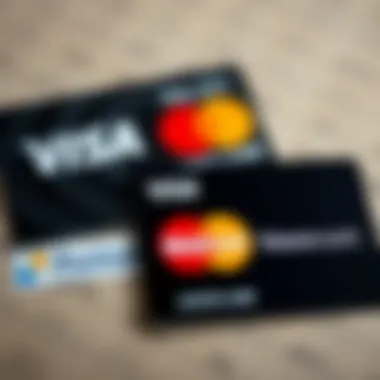Key Differences Between Visa and MasterCard Explained


Intro
When it comes to swiping a card or tapping to pay, two names probably stand out most—Visa and MasterCard. These two giants dominate the landscape of payment networks and serve as the backbone for much of today’s consumer transactions. They’re not just logos on your card; they represent vastly different operational structures and perceived benefits, making it essential for consumers to understand what separates them and where they overlap. In a world where financial literacy is becoming increasingly important, grasping the distinctions between Visa and MasterCard can help you make smarter decisions regarding how and where you spend your hard-earned cash.
Let's roll up our sleeves and dive into the nitty-gritty of what defines these two payment networks, highlighting their similarities and differences along the way.
Prelims to Payment Networks
In the rapidly evolving world of finance, understanding payment networks is not just useful; it is essential. As we navigate through everyday transactions, from buying coffee to shopping for holiday gifts, payment networks serve as the invisible threads that connect consumers, merchants, and financial institutions. This article centers around two of the most recognized players in this space: Visa and MasterCard. By unpacking their roles and functionalities, we can gain insightful clarity about the mechanics behind our daily transactions.
The importance of grasping how payment networks operate lies in fostering a well-informed consumer mindset. For young professionals entering the job market, families managing household budgets, and students juggling expenses, awareness of these systems can lead to smarter and more economical financial decisions. The discussions surrounding their fees, security features, and global reach will empower readers to assess which card network aligns best with their needs and lifestyle.
To truly appreciate Visa and MasterCard, one must first understand the fundamental role of payment processors.
The Role of Payment Processors
Payment processors act as facilitators, bridging the gap between the customer, the merchant, and the banks involved in a transaction. When you swipe your card, the payment processor takes on the critical job of transmitting transaction data, securing the interaction, and ensuring that funds move smoothly from one account to another. With advanced technology, these processors evaluate customer information quickly and safely. They analyze elements like the card’s validity, customer credit limits, and fraud alerts in each split second. Without this service, purchasing would be cumbersome therefore, they are essential for effective commerce.
Among the giants in this field are companies such as PayPal, Square, and Stripe. Each of these platforms has unique approaches to processing payments, which also influence the relationship between cardholders and the payment networks they employ. \n
Global Financial Transactions Overview
When examining global financial transactions, it is important to recognize the vastness of the systems and networks that underpin them. Visa and MasterCard not only operate as individual entities but maintain a significant presence across the globe. According to industry reports, both networks account for a large portion of card transactions worldwide.
This widespread acceptance brings several benefits:
- Convenience: Customers can use their cards in numerous countries and online platforms, promoting a seamless purchasing experience.
- Security: With enhanced measures like encryption and fraud detection systems, users can feel reassured that their financial information is safeguarded.
- Financial Inclusion: These networks champion easier access to banking and payment systems, particularly in developing regions.
Visa: A Closer Look
Understanding Visa requires diving into its historical roots, current offerings, and breadth of its impact on global transactions. The significance of this section lies in the multifaceted nature of Visa's operations which influences countless consumers and businesses worldwide. Readers will find this examination beneficial as it enables them to grasp not only how Visa contributes to the payment ecosystem but also how it compares with its competitor, MasterCard. This thorough understanding can aid in making more informed choices about their payment options.
History and Evolution
Visa's journey began in the late 1950s when Bank of America first launched the BankAmericard. Over the decades, it transformed into a universally recognized brand, adapting to the technological advancements and changes in consumer behavior. By 1976, the company evolved into Visa, reflecting its mission to become a standard in global commerce. The evolution of Visa illustrates how a financial service can adapt and thrive, highlighting the importance of innovation in a landscape that continuously changes.
Types of Visa Products
Credit Cards
Visa credit cards are a cornerstone of the Visa lineup. They offer a way for users to borrow funds up to a pre-approved limit, allowing for larger purchases and the ability to manage cash flow better. A key characteristic of these credit cards is the opportunity to earn rewards on purchases, making them a popular choice for consumers looking to maximize their spending potential. One unique aspect of Visa credit cards is the ability to build or improve one’s credit score through responsible usage. However, drawbacks include the potential for accruing high-interest debt if balances are not paid off in full each month.
Debit Cards
On the other hand, Visa debit cards directly link to a user's bank account, enabling access to funds that they already possess. This characteristic makes them a prudent choice for those who want to avoid debt, since purchases are limited to the amount available in their accounts. A benefit of using Visa debit cards is the lack of interest charges, unlike credit cards. However, users might find that debit cards lack some rewards programs that credit cards typically provide, limiting the potential for earning bonuses on spending.
Prepaid Cards


Lastly, Visa prepaid cards serve as another option in the Visa product lineup. These cards can be loaded with a predetermined amount of money and used until the balance reaches zero. They are particularly favored by individuals who want control over their spending without the risk of overdraft fees. A key feature of prepaid cards is their suitability for budgeting, as users cannot spend beyond what’s preloaded. However, they can come with various fees, such as activation costs and reload charges, which may deter potential users.
Visa’s Global Reach
Visa’s network extends far and wide, with acceptance in over 200 countries. This global presence ensures that consumers can use their Visa cards for various transactions, both locally and internationally. The infrastructure that Visa has built supports millions of merchants and ATMs, making it one of the most reliable payment networks in the world. With continuous efforts to expand its services and partnerships, Visa is working towards ensuring seamless transactions across borders, thus positioning itself as a favored choice among travelers and global businesses alike.
In summary, Visa offers diverse products catering to different consumer needs, all while maintaining a strong global presence that enhances its utility. This depth of offerings and widespread acceptance highlights Visa's importance not just as a payment method but as an integral part of everyday financial interactions.
MasterCard: An Overview
When discussing payment networks, understanding the role of MasterCard is crucial. Not only does it play a significant role in global financial transactions, but it also offers a wide array of products tailored to various consumer needs. The versatility and adaptability of MasterCard are evident when considering its broad range of offerings, which cater to a diverse demographic, from frequent travelers to everyday shoppers. In this overview, we will explore the historical context of MasterCard, delve into its various product types, and examine its global presence. This understanding will give readers the insights necessary to make informed financial decisions that align with their lifestyles and financial goals.
History and Development Timeline
MasterCard has a rich history that dates back to 1966 when it was founded as the Interbank Card Association. Over the decades, it has evolved significantly, merging with various financial institutions and embracing technological innovations. Initially, its primary focus was on enabling consumers to make purchases through its credit card system. However, with the rise of digital banking and online transactions, MasterCard adapted by introducing contactless payments and enhancing its security features.
The path of MasterCard is marked by key milestones, such as:
- The launch of its first debit card in the early 1980s, expanding its reach beyond just credit.
- The adoption of advanced technology like EMV chips in the 1990s, which improved the security of transactions.
- The recent foray into the realm of cryptocurrencies and blockchain technology, positioning itself as a progressive player in the payment industry.
This timeline of changes showcases MasterCard's commitment to innovation and meeting the evolving demands of consumers.
Diverse Offerings of MasterCard
Credit Cards
MasterCard’s credit cards stand out due to their flexibility and rewarding benefits. Many people prefer them because they offer convenient purchasing power and various bonus programs for different spending categories. A notable feature is the opportunity to accumulate points that can be spent on travel, merchandise, or cashback. This makes these cards particularly attractive for individuals who like to maximize their spending power.
However, it's essential to note that credit cards also carry the risk of accumulating debt if not managed responsibly. High-interest rates can quickly lead to due balances that, if not paid in full, can become burdensome for users. Still, for financially disciplined individuals, MasterCard credit cards can be a valuable tool for building credit history and managing cash flow.
Debit Cards
MasterCard debit cards provide a practical solution for consumers who prefer to spend within their means. Linked directly to a checking account, these cards enable immediate access to funds without the risk of overspending. This feature is primarily what makes them ideal for young professionals or college students trying to budget wisely. Many debit cards from MasterCard also come with security features like fraud detection and zero liability for unauthorized transactions, which adds an extra layer of reassurance.
One limitation, however, is that rewards are often less favorable compared to credit cards, which can deter some users looking for those extra perks. Regardless, many appreciate the simplicity and directness of debit cards as a financial management tool.
Prepaid Cards
Prepaid cards from MasterCard cater to those who may not have access to traditional banking options or prefer a controlled spending method. Unlike credit or debit cards, these require users to load funds upfront. A key characteristic of prepaid cards is that they help in managing spending effectively since one cannot spend more than what’s already loaded. This makes it suitable for budget-conscious individuals who want to avoid surprises at the end of the month.
The downside can include fees for reloading or maintenance, which can add up over time. Yet, for many, the benefits of having a non-reusable way to spend money outweigh the drawbacks. They are particularly useful for travel or gift purposes, as they can be accepted almost anywhere MasterCard is recognized.
MasterCard’s Global Network
MasterCard boasts an extensive global network, making it one of the most recognized payment brands worldwide. With millions of locations accepting its cards across various countries and regions, travelers frequently rely on MasterCard for transactions overseas. Its international reach ensures that cardholders can shop or withdraw cash regardless of the currency, thanks to favorable exchange rates in many instances.
Furthermore, Launched programs like MasterCard’s Worldwide Safety features, which offers added security and peace of mind, demonstrate its commitment to providing a secure payment environment. In this connected world, having a payment network that spans borders not only enhances convenience but builds trust in the brand.


Overall, understanding MasterCard’s historical context and diverse offerings is essential for discerning consumers. This insight allows individuals to assess how MasterCard cards might fit into their financial practices.
Comparative Analysis of Visa and MasterCard
When it comes to financial transactions, understanding the distinctions between Visa and MasterCard is crucial. Their differences extend beyond logos and marketing strategies; they shape consumer experiences, accessibility, and financial comfort. An informed analysis of these two giants enables individuals to select the card that best aligns with their personal and financial needs.
Acceptance and Availability
Acceptance plays a significant role in determining the usability of any credit or debit card. Visa is known for its wide acceptance globally, boasting millions of merchants. Whether you’re strutting through the streets of New York or cozying up in a cafe in Paris, most places easily accept Visa. MasterCard isn’t far behind, with a vast network as well. In many cases, the choice between these two may come down to where you intend to use them. Some niche businesses might have a preference for one network over the other, so it’s worth checking in advance.
"Your card is only as good as the places it is accepted. Never leave home without knowing your options."
Fees Associated with Each Network
Processing Fees
Processing fees are a feature both Visa and MasterCard implement during transactions. These are typically charged to merchants, which in turn can influence the costs handed down to consumers. Visa generally has a smoother transaction process, often described favorably by merchants. This efficiency is a major draw, making some retailers favor Visa cards due to perceived cost-effectiveness. On the flip side, mastering the processing fees of MasterCard can unlock unique vendor discounts in certain regions, inviting consumer curiosity.
Annual Fees
Annual fees can vary widely depending on the specific card offerings from both networks. Many consumers find no annual fee cards appealing, as they allow for use without the upfront cost. The catch? Cards with annual fees often come with extra perks such as higher rewards or additional features. While Visa may provide more no-fee options, MasterCard tends to offer more premium cards, which could justify those annual dues with enticing rewards.
Foreign Transaction Fees
Foreign transaction fees can catch travelers off guard. Visa and MasterCard often impose these when purchases are made outside the home currency, and the rates can differ. Understanding these fees can save a traveler a pretty penny. Visa typically offers competitive rates, while MasterCard may have cards with no foreign transaction fees, which might be a traveler’s best friend.
Rewards and Benefits Comparison
Cash Back Options
Cash back rewards have become a vital component in the decision-making process for many consumers. Visa features cash back options that appeal to everyday spenders—think groceries, gas, and dining. These rewards can add up quickly, giving users a little something extra at the end of the month. MasterCard also offers enticing cash back deals but often goes a step further with promotional categories, attracting those who like to maximize their earnings in specific spending areas.
Point Systems
Point systems vary between Visa and MasterCard offerings, catering to different customer preferences. Visa often utilizes straightforward point accrual tied to purchases, while MasterCard has innovative systems allowing users to convert their points into airline miles or hotel stays, enriching lifestyle choices. Ultimately, which system one prefers relies on personal spending habits.
Partner Offers
Partners are a sneaky way to rack up rewards faster. Both networks strike numerous partnerships with retailers and service providers, enhancing the benefits that cardholders can reap. Visa partners with a diverse array of retailers, while MasterCard might align with more premium brands. Understanding which benefits tie into with preferred brands or services can optimize reward potential, making financial decisions even smarter.
Security Features and Fraud Protection
Tokenization
Tokenization is a trendy buzzword that actually points to a pivotal security feature. Both networks employ tokenization to keep sensitive payment data safe. In essence, instead of using the actual card numbers in online or mobile transactions, a system generates a one-time-use code—called a token. This protects users from potential data breaches and fraudulent transactions, which is becoming more critical as online shopping proliferates.
Zero Liability Policies


When it comes to liability, both Visa and MasterCard stand strong with their zero liability policies. This means cardholders won’t be held responsible for unauthorized purchases, boosting peace of mind. As a consumer, knowing that you’re living under a protective umbrella can affect how you perceive security in online and offline transactions.
Fraud Monitoring
Fraud monitoring is another area where both networks pour effort into safeguarding users. Visa and MasterCard employ various systems to detect and alert users to suspicious activity, typically reaching out to cardholders proactively. This hands-on monitoring allows users to address potential fraud before it spirals out of control, offering a comforting safety net.
The comparative analysis between Visa and MasterCard lays the groundwork for making educated choices about daily financial tools. Consumers should scrutinize acceptance, fees, rewards, and security features before making their final decision.
User Experiences and Preferences
Understanding user experiences and preferences is vital when it comes to navigating the complex world of payment networks like Visa and MasterCard. These two giants not only offer cards with various features but also craft different experiences for customers that go beyond just financial transactions. When users consider a payment method, they often reflect on their interactions, feelings, and overall satisfaction with their cards. This discussion reveals insights into how individuals perceive these networks and how their choices are frequently influenced by personal lifestyles.
Consumer Perceptions
Consumer perceptions are shaped by numerous elements, including marketing, usability, and overall reputation. For instance, a survey might show that many people associate MasterCard with innovative technology, while Visa may be seen as a reliable and longstanding choice. This perception affects consumer trust, which is crucial in services involving money transactions.
- Trust and Reliability: Many feel safer using Visa due to its long history. It often appears in discussions as the default option when a merchant accepts credit cards, creating a mental association with reliability.
- Innovation: MasterCard frequently markets itself as a forward-thinking option. Through campaigns emphasizing technology, they’ve positioned themselves as the network that embraces innovation, appealing to tech-savvy users.
To illustrate, consider someone using a credit card for the first time. They may choose Visa because their parents always used it, embedding a notion of dependability in their minds.
Moreover, social media plays a role in shaping these perceptions, with platforms like Reddit highlighting positive or negative experiences shared by various consumers. This gathering of opinions can influence the choices of young professionals, families, and students alike, ultimately molding the way they view each brand.
Choosing Based on Lifestyle
Choosing between Visa and MasterCard often comes down to personal lifestyle choices. Different individuals have various financial needs and habits, which can sway their preferences.
- Frequent Travelers: Some credit cards come with perks like no foreign transaction fees or travel rewards. For instance, certain Visa cards are renowned for these benefits, making them appealing for globetrotters who seek to maximize their savings.
- Everyday Spending: Families or students may find MasterCard’s cash-back rewards attractive. This type of card can help them stretch their budget, providing a Return on Investment with every purchase. It's a smart way to make the most of daily expenses.
- Shopping Enthusiasts: Both networks often collaborate with retailers to offer exclusive deals. Loyalty is a significant aspect; some users stick to one card because of their favorite store's partnership with that network. Finding a card with the best perks relevant to personal shopping habits can be essential.
In summary, the intersection of user experiences and brand perceptions plays a crucial role in how individuals relate to Visa and MasterCard. Ultimately, whether one prefers Visa’s dependability or MasterCard’s innovative aura depends significantly on their lifestyle, priorities, and experiences with these brands in the payments space.
"Your choice in a payment network might not just reflect your financial savvy, but also your identity and values."
For more detailed reviews and discussions about consumer experiences, you can check out forums on Reddit or insights available on Wikipedia which expound on the history and evolution of both companies. To understand the latest trends, visiting Britannica could provide a scholarly perspective.
Final Considerations
The closing segment of this article centers on the crucial nature of understanding the differences between Visa and MasterCard. While both serve as significant players in the payment network landscape, their unique features and offerings can have a pronounced impact on a user's financial experience. Knowing these distinctions can guide people toward making more informed decisions, tailoring their choices to fit their specific lifestyle, spending habits, and financial goals.
Making an Informed Choice
When deciding between Visa and MasterCard, it’s paramount to consider a few factors that can influence your overall experience:
- Acceptance: While both networks boast widespread acceptance, there may be specific merchants or regions where one brand is favored over the other. It's wise to check which is more prevalent in your locality or the areas you frequently visit.
- Fee Structure: It’s not just about which card looks good in your wallet. Understanding the fee structures associated with Visa and MasterCard—such as annual fees, foreign transaction fees, and interest rates—can help you save significantly over time. A card with no foreign transaction fees might be invaluable for someone who travels often, while a low annual fee could appeal more to budget-conscious consumers.
- Rewards Programs: Different cards under each network offer various rewards. If you’re a frequent shopper, consider which card provides better cash back on purchases or points for traveling. Look into partnerships as well—certain alliances can lead to enhanced benefits tailored to your lifestyle.
Ultimately, making an informed choice means taking the time to evaluate your specific needs against what each network offers. Don’t just settle because your friend swears by one; dig into the analytics yourself.
Future Trends in Payment Networks
The world of payment networks is continually evolving, influenced by technology, consumer behavior, and even global events. Here’s what to look out for as we move further into the 21st century:
- Digital Payment Integration: With the surge in mobile wallets like Apple Pay and Google Wallet, both Visa and MasterCard are adapting their services to integrate seamlessly with these trends. Expect an increasing number of features that promote contactless payments, making transactions faster and more convenient.
- Enhanced Security Measures: As the cyber landscape keeps shifting, advancements in fraud prevention and cybersecurity are paramount. Innovations like biometric authentication or AI-driven fraud detection will likely become standards, pushing both Visa and MasterCard to enhance their security frameworks.
- Sustainability Movement: Consumers today are leaning more towards brands that reflect their values, including concerns for environmental sustainability. Both networks are exploring ways to present eco-friendly card options and promote businesses that align with these values.
In essence, as technology progresses, Visa and MasterCard will continue to adapt, aiming to meet the expectations and needs of a new generation of consumers. Keeping an eye on these trends will help you navigate your payment options and help ensure you're making the best choice for your financial future.
Knowing the ins and outs of your payment options can turn you from a passive spender into a savvy financial navigator.







